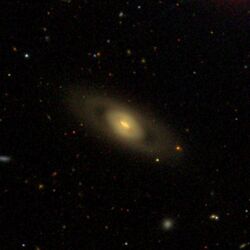Astronomy:NGC 5384
From HandWiki
Short description: Galaxy in the constellation Virgo
Coordinates: ![]() 13h 58m 12.850s, +06° 31′ 04.80″
13h 58m 12.850s, +06° 31′ 04.80″
| {{{name}}} | |
|---|---|
 SDSS image of NGC 5384 | |
| Observation data (J2000 epoch) | |
| Constellation | Virgo |
| Right ascension | 13h 58m 12.850s[1] |
| Declination | +06° 31′ 04.80″[1] |
| Redshift | 0.01699[2] |
| Helio radial velocity | 5050 ± 3 km/s[2] |
| Distance | 258.3 ± 18.2 Mly (79.21 ± 5.57 Mpc)[3] |
| Characteristics | |
| Type | S0[3] |
| Apparent size (V) | 0.617′ × 0.419′[2] |
| Other designations | |
| UGC 8886, MCG+01-36-008, PGC 49707[2] | |
NGC 5384 is a lenticular galaxy in the constellation Virgo. It was discovered on May 8, 1864, by the astronomer Albert Marth.[4] It is located about 250 million light-years (79.21 megaparsecs) away.[3]
References
- ↑ 1.0 1.1 Skrutskie, Michael F.; Cutri, Roc M.; Stiening, Rae; Weinberg, Martin D.; Schneider, Stephen E.; Carpenter, John M.; Beichman, Charles A.; Capps, Richard W. et al. (1 February 2006). "The Two Micron All Sky Survey (2MASS)". The Astronomical Journal 131 (2): 1163–1183. doi:10.1086/498708. ISSN 0004-6256. Bibcode: 2006AJ....131.1163S.
- ↑ 2.0 2.1 2.2 2.3 "NGC 5384". SIMBAD. Centre de données astronomiques de Strasbourg. http://simbad.u-strasbg.fr/simbad/sim-basic?Ident=NGC+5384.
- ↑ 3.0 3.1 3.2 "Results for object NGC 5384 (NGC 5384)". NASA/IPAC Extragalactic Database. California Institute of Technology. https://ned.ipac.caltech.edu/byname?objname=NGC%205384&hconst=67.8&omegam=0.308&omegav=0.692&wmap=4&corr_z=1. Retrieved 2021-04-22.
- ↑ "New General Catalog Objects: NGC 5300 - 5349". https://cseligman.com/text/atlas/ngc53a.htm#5384.
External links
 |

